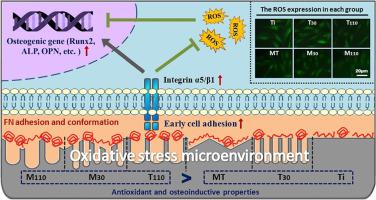Biomaterials Advances ( IF 5.5 ) Pub Date : 2021-02-16 , DOI: 10.1016/j.msec.2021.111969 Pingping Ma , Yonglin Yu , Kendrick Hii Ru Yie , Kai Fang , Zixin Zhou , Xiaoyi Pan , Zhennan Deng , Xinkun Shen , Jinsong Liu

|
Excessive accumulation of oxidative intermediates in the elderly significantly aggravates bone degradation and hinders the osseointegration of topological titanium (Ti) implants. Thus, it is of great significance to evaluate the antioxidant and osteoinduction capabilities of various nano, micro or micro/nano-composite structures under oxidative stress (OS) microenvironment. In this study, we discovered that 110 nm titania nanotubes (TNTs) enhanced the adsorption of fibronectin (FN) proteins onto smooth and rough titanium surfaces to varying degrees. Compared with Ti and 30 nm TNTs (T30) groups, cells on 110 nm TNTs (T110), microstructure/30 nm TNTs (M30) and microstructure/110 nm TNTs (M110) had smaller area, lower reactive oxygen species (ROS), and better proliferation/osteogenic differentiation abilities under OS condition, but there was no significant difference among the three groups. In addition, combined with our previous study, we suggested that T110, M30 and M110 resistance to OS was also strongly associated with the high expression of FN-receptor integrin α5 or β1. All the findings indicated that the micro/nano-composed structures (M30 & M110) had similar anti-oxidation and osteogenesis abilities to T110, which provided guidance for the application of different titanium implants with different topologies in the elderly.
中文翻译:

不同微观/纳米结构的钛对成骨细胞抗氧化应激能力的影响
老年人中氧化中间体的过度积累会严重加剧骨骼退化,并阻碍拓扑钛(Ti)植入物的骨整合。因此,评估在氧化应激(OS)微环境下各种纳米,微米或微米/微米/纳米复合结构的抗氧化和骨诱导能力具有重要意义。在这项研究中,我们发现110 nm的二氧化钛纳米管(TNT)可以不同程度地增强纤连蛋白(FN)蛋白在光滑和粗糙的钛表面上的吸附。与Ti和30 nm TNT(T 30)组相比,110 nm TNT(T 110),微结构/ 30 nm TNT(M 30)和微结构/ 110 nm TNT(M 110)上的细胞)在OS条件下具有较小的面积,较低的活性氧(ROS)和较好的增殖/成骨分化能力,但三组之间无显着差异。此外,结合我们先前的研究,我们认为T 110,M 30和M 110对OS的抵抗力也与FN受体整合素α5或β1的高表达密切相关。所有研究结果表明,由微米/纳米组成的结构(M 30和M 110)具有与T 110类似的抗氧化和成骨能力,这为老年人使用具有不同拓扑结构的不同钛植入物提供了指导。











































 京公网安备 11010802027423号
京公网安备 11010802027423号